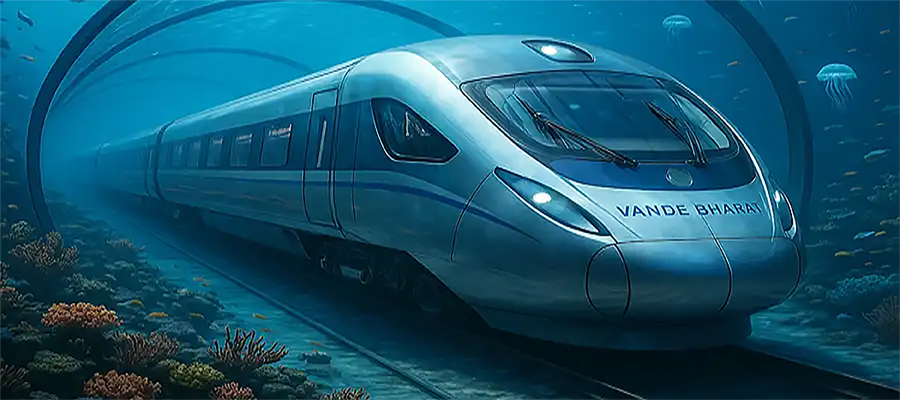Imagine stepping onto a train in Miami, settling into a plush seat, and arriving in London just in time for afternoon tea—all without ever leaving the ground. No TSA lines, no jet lag, just a futuristic ride beneath the waves. This is the promise of underwater trains, a game-changing innovation that’s set to revolutionize global travel. For Americans, who crisscrossed the globe to the tune of 80 million international trips in 2023, this technology could mean faster, greener, and more exciting ways to explore. From coast to coast, underwater trains are diving into the future—and the U.S. is ready to ride the wave.
What Exactly Are Underwater Trains?
Underwater trains aren’t your average commuter rail. These high-speed marvels travel through tunnels carved beneath oceans, using cutting-edge tech like magnetic levitation (maglev) or vacuum-sealed tubes to hit speeds of 600 to 1,000 miles per hour. That’s faster than a Boeing 737, with none of the turbulence. Picture the Eurostar’s Channel Tunnel on steroids, linking not just nearby nations but entire continents.
The idea is already taking shape globally—think Dubai to Mumbai or Japan to South Korea. For the U.S., the dream is bigger: a transatlantic line from New York to London or a Pacific route from LA to Tokyo. It’s bold, ambitious, and quintessentially American—a chance to shrink the world without ever stepping on a plane.
Why Americans Should Care
For U.S. travelers, underwater trains are a triple win: speed, sustainability, and style. Let’s start with speed. A flight from New York to London takes about seven hours, plus airport hassles. An underwater train could cut that to four hours, door to door. LA to Tokyo? Under six hours. For busy Americans juggling work and wanderlust, that’s a game-changer.
Then there’s the eco-angle. Air travel pumps out 2.5% of global CO2 emissions, and with climate change on everyone’s mind, greener options are in demand. A 2024 Booking.com survey found 74% of U.S. travelers crave sustainable travel solutions. Underwater trains, powered by renewables like wind or solar, could slash emissions while whisking you across the globe. It’s a win for the planet and your Instagram feed—imagine snapping pics through reinforced windows as fish dart by.
Style’s the cherry on top. Americans love innovation—think Tesla or SpaceX—and underwater trains fit that vibe. They’re not just transport; they’re an experience, blending luxury with sci-fi flair. For a nation that thrives on being first, this could be our next big thing.
The Tech Making It Happen
So, how do you build a train that conquers the ocean? It starts with tunnels—massive, watertight tubes sunk below the seabed, designed to handle pressure, currents, and quakes. Maglev tech lifts trains off the tracks with magnets, cutting friction and boosting speed. Hyperloop systems, like those tested by Virgin Hyperloop, use near-vacuum tubes to push the limits even further.
The U.S. has the chops for this. We’ve built wonders like the Golden Gate Bridge and the Interstate Highway System. A 3,500-mile tunnel under the Atlantic? Daunting, sure, but not impossible. With companies like Hyperloop and government interest in infrastructure, the pieces are falling into place.
A Boost for the U.S. Economy and Culture
Underwater trains aren’t just about travel—they’re about opportunity. Construction alone could create thousands of jobs, from engineers in Silicon Valley to welders in the Rust Belt. Ports like New York, Miami, and Seattle could become global gateways, supercharging trade. Imagine shipping goods from California to Europe in hours, not days—supply chains would transform overnight.
Culturally, it’s a bridge to the world. Americans could pop over to Paris for a weekend baguette or catch Carnival in Rio on a whim. Closer ties with other continents could spark new food trends (sushi burritos, anyone?), fashion crazes, and music mashups. For a melting-pot nation, underwater trains could make us even more connected.
The Road—or Tunnel—Ahead
Of course, there are hurdles. Cost is the big one—a transatlantic line could top $100 billion, dwarfing even the priciest U.S. projects. Funding would need public-private teamwork, a tough ask in today’s political climate. Engineering’s another beast: tunneling under oceans is risky, and maintenance would be a nightmare. Safety’s critical too—what if a train stalls miles below the surface? Backup plans would need to be bulletproof.
But here’s the thing: America thrives on big bets. We put a man on the moon and wired the world with the internet. Underwater trains could be our next moonshot, blending tech, vision, and a little swagger. If Europe and Asia are already testing the waters, why shouldn’t we dive in?
The Future Is Submerged
Underwater trains are more than a cool idea—they’re a glimpse at how Americans will travel tomorrow. Faster than planes, greener than jets, and packed with potential, they could link the U.S. to the world like never before. Whether it’s a quick hop to London or a jaunt to Japan, the future of global travel is underwater—and it’s time for the U.S. to lead the charge. So, next time you’re stuck in traffic or dreading a red-eye flight, dream a little deeper. The train’s coming—and it’s ready to take you under the sea.
For more insights on cutting-edge travel innovations, visit – Truescoop News.
